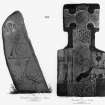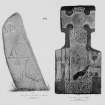St Vigeans
Cross Slab (Early Medieval)
Site Name St Vigeans
Classification Cross Slab (Early Medieval)
Canmore ID 35587
Site Number NO64SW 3.07
NGR NO 6383 4294
Datum OSGB36 - NGR
Permalink http://canmore.org.uk/site/35587
- Council Angus
- Parish Arbroath And St Vigeans
- Former Region Tayside
- Former District Angus
- Former County Angus
St Vigeans 7 (St Vigianus), Angus, cross-slab fragment
Measurements: H 1.67m, W 0.92m, D 0.20m
Stone type: sandstone
Place of discovery: NO c 6384 4289
Present location: in St Vigeans Museum (HES).
Evidence for discovery: found upright but almost entirely buried in the churchyard in the first half of the nineteenth century. It was set upright in the churchyard initially and later built into the church at the time of the 1870s restoration. It was taken into St Vigeans Museum in 1960.
Present condition: severely trimmed and badly weathered, face C more so than face A.
Description
This was once a magnificent great slab with a cross carved in relief on both broad faces, but it has been trimmed down for re-use, possibly as a headstone with just the crosses visible. A small fragment, St Vigeans no 26 (now missing), may belong to the terminal of the left-hand arm of the cross on face A. Geddes discusses in detail the complex iconography of this monument (2017, vol 1, 85-106).
On face A, an equal-armed cross is set on a shaft that stands on a rectilinear pedestal. The components of the cross are bordered by roll mouldings, and spirals flank the wide circular armpits. The centre of the cross is a roundel filled with interlace in a cruciform pattern, the two side-arms are filled with diagonal key pattern, and the upper and lower arm are filled with loose interlace. The circular interlace patterns in the lower arm are echoed in the shaft, which is densely packed with eight triple spiral designs, each of which has zoomorphic or anthropomorphic terminals. The pedestal base contains an elegant pattern of open interlace. In the background to the cross on the left are two figures in long robes, facing one another across the body of a naked man hanging upside down over a square object. Beneath are two tonsured clerics facing the cross, wearing long hooded cloaks and carrying staffs. The cleric on the left has a book satchel hanging round his neck. To the right of the shaft there are two seated figures, facing one another and holding a circular object, while below stands a bull with a small naked figure crouched beneath his head. Face A is notable for the fine details of its carving of garments and shoes.
Face C is badly defaced but it bore another equal-armed cross, this time with a square central panel and interlaced ornament. The narrow faces of the slab are also damaged.
Date range: eighth or ninth century.
Primary references: ECMS pt 3, 267-9; Geddes 2017, no VIG007.
Desk-based information compiled by A Ritchie 2019
Reference (1964)
Upright cross-slab severely trimmed in some late re-use. On the front a long-shafted cross stands upon an oblong base. On the left of the shaft are five figures. On the right of the shaft is a pair of enthroned robed figures holding a circular object between them. Below them is a bull confronted by a naked kneeling man with rod or knife upraised to its throat.
The other side of the slab was richly sculptured also. The head of another splendid cross can still be seen, and traces of sculpture beneath it on the left, but the surface has been grieviously damaged. The subject-matter of this magnificent memorial - it must have been seven feet high or more - is of great interest although inexplicable still. Moved from St Vigeans Church to museum in 1960 (NO 6383 4294).
S Cruden 1964














































